Summary_常用句式
- 格式:doc
- 大小:46.00 KB
- 文档页数:9

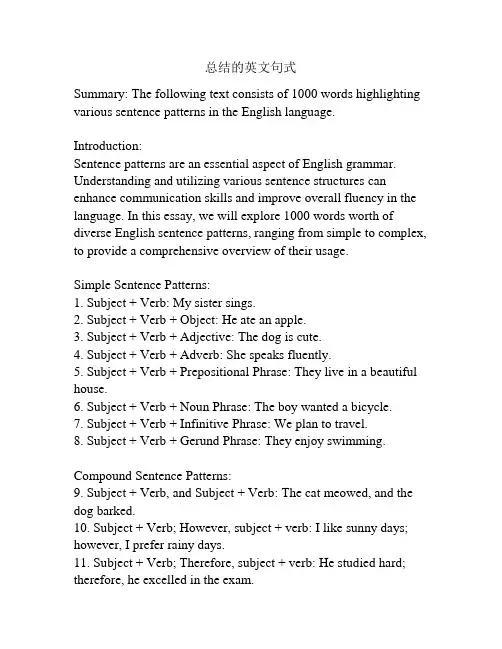
总结的英文句式Summary: The following text consists of 1000 words highlighting various sentence patterns in the English language. Introduction:Sentence patterns are an essential aspect of English grammar. Understanding and utilizing various sentence structures can enhance communication skills and improve overall fluency in the language. In this essay, we will explore 1000 words worth of diverse English sentence patterns, ranging from simple to complex, to provide a comprehensive overview of their usage.Simple Sentence Patterns:1. Subject + Verb: My sister sings.2. Subject + Verb + Object: He ate an apple.3. Subject + Verb + Adjective: The dog is cute.4. Subject + Verb + Adverb: She speaks fluently.5. Subject + Verb + Prepositional Phrase: They live in a beautiful house.6. Subject + Verb + Noun Phrase: The boy wanted a bicycle.7. Subject + Verb + Infinitive Phrase: We plan to travel.8. Subject + Verb + Gerund Phrase: They enjoy swimming. Compound Sentence Patterns:9. Subject + Verb, and Subject + Verb: The cat meowed, and the dog barked.10. Subject + Verb; However, subject + verb: I like sunny days; however, I prefer rainy days.11. Subject + Verb; Therefore, subject + verb: He studied hard; therefore, he excelled in the exam.12. Subject + Verb; Yet, subject + verb: She failed the test; yet, she remained optimistic.Complex Sentence Patterns:13. Subordinating Conjunction + Independent Clause: Although it rained, we went for a walk.14. Independent Clause + Coordinating Conjunction + Independent Clause: She likes to dance, but he prefers to sing.15. Adverbial Clause + Main Clause: When I arrived home, I noticed the door was open.16. Noun Clause + Main Clause: What he said made me happy.17. Adjective Clause + Main Clause: The book that I read was fascinating.Conditional Sentence Patterns:18. If + Present Simple, Present Simple: If it rains, I stay at home.19. If + Present Simple, Will + Verb: If she calls, I will answer.20. If + Past Simple, Would + Verb: If I had time, I would visit you.21. If + Past Perfect, Would + Have + Past Participle: If I had studied, I would have passed the exam.Passive Sentence Patterns:22. Subject + To Be + Past Participle: The food was eaten by the dog.23. Subject + To Be + Being + Past Participle: The car is being repaired by the mechanic.Imperative Sentence Patterns:24. Verb: Study hard!25. Verb + Adverb: Please, sit quietly.26. Verb + Direct Object: Eat your dinner.Exclamatory Sentence Patterns:27. What + noun phrase + subject + verb! What a beautiful flower it is!28. How + adjective or adverb: How fast he runs!29. What + subject + verb + object! What a fantastic movie it was! Interrogative Sentence Patterns:30. Yes/No Question: Are you coming with us?31. Wh- Question: What is your favorite color?32. Tag Question: We should go, shouldn't we?Conclusion:Mastering various sentence patterns in English allows for more versatile and expressive communication. From basic simple sentences to complex conditionals, passives, imperatives, exclamatory and interrogative sentences, understanding and utilizing these patterns enhances language skills significantly. Regular practice and exposure to different sentence structures contribute to becoming a confident and effective English speaker and writer.。

英文作文总结句式当你在总结英文作文时,可以使用一系列丰富多样的句式,以突出你对主题的深刻理解和全面总结。
以下是一些常用的总结句式:1. In conclusion, [restate main idea].例如,In conclusion, it is evident that education plays a pivotal role in shaping individuals' futures.2. To sum up, [reiterate key points].例如,To sum up, effective communication, time management, and teamwork are essential skills for successin the workplace.3. Overall, [provide overall assessment].例如,Overall, the implementation of renewableenergy sources is crucial for mitigating climate change and ensuring a sustainable future.4. In summary, [briefly summarize main arguments].例如,In summary, the novel explores themes of love, sacrifice, and the pursuit of identity through the lens of its diverse characters.5. To conclude, [present final thoughts].例如,To conclude, the government should prioritize policies that promote economic equality and social justice for all citizens.6. Taking everything into account, [offer comprehensive perspective].例如,Taking everything into account, it is clear that globalization has both positive and negative impacts on local economies and cultures.7. In light of these points, [draw final conclusion].例如,In light of these points, it is imperativethat individuals take proactive measures to reduce their carbon footprint and combat climate change.8. All things considered, [restate main idea and implications].例如,All things considered, the rise of artificial intelligence presents both opportunities and challenges for the future of work and society.9. On the whole, [provide overall assessment].例如,On the whole, technological advancements have revolutionized various aspects of human life, from communication to healthcare.10. To summarize, [briefly encapsulate main arguments].例如,To summarize, the research highlights the importance of early childhood education in fostering cognitive development and academic success.这些句式可以帮助你有效地总结英文作文,突出重点,展示对主题的全面理解。
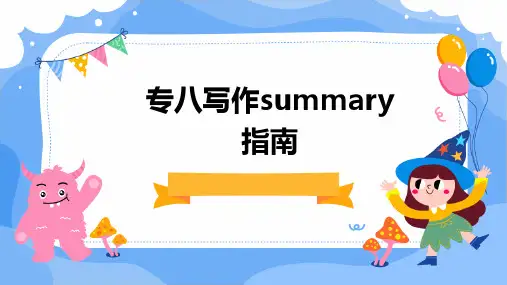

考博英语summary作文及翻译部分博士研究生招生院校考博英语题型中作文部分要求学生写200字左右英文摘要即summary,对于很多没有接触过的考试感到无从下笔,下面新东方在线考博频道将为大家详细介绍2017考博英语作文摘要的写作步骤。
摘要写作(summary writing)是一种控制性的作文形式,它能使学生通过阅读原文,吸收原文的文章结构与语言方面的长处,写出内容一致、结构近似、语言简洁的短文。
另外,对培养学生善于抓住文章重点的能力也有很大帮助,有利于他们在实际写作中避免面面俱到,事无巨细,一一罗列的不良倾向。
这种写作既要准确理解原文,又要能综合概括;既能培养欣赏能力,又能训练书面表达能力。
因此,用英文写摘要,对学习英语写作的学生来说,不失为一种切合实际的方法。
考博英语作文摘要是对一篇文章的主题思想的简单陈述。
它用最简洁的语言概括了原文的主题。
写摘要主要包括三个步骤:(1)阅读;(2)写作;(3)修改成文。
第一步:阅读A.认真阅读给定的原文材料。
如果一遍不能理解,就多读两遍。
阅读次数越多,你对原文的理解就越深刻。
B.给摘要起一个标题。
用那些能概括文章主题思想的单词、短语或短句子作为标题。
也可以采用文中的主题句作为标题。
主题句往往出现在文章的开头或结尾。
一个好标题有助于确定文章的中心思想。
C.现在,就该决定原文中哪些部分重要,哪些部分次重要了。
对重要部分的主要观点进行概括。
D.简要地记下主要观点——主题、标题、细节等你认为对概括摘要重要的东西。
第二步:动手写作A. 摘要应该只有原文的三分之一或四分之一长。
因此首先数一下原文的字数,然后除以三,得到一个数字。
摘要的字数可以少于这个数字,但是千万不能超过这个数字。
B. 摘要应全部用自己的话完成。
不要引用原文的句子。
C. 应该遵循原文的逻辑顺序。
这样你就不必重新组织观点、事实。
D. 摘要必须全面、清晰地表明原文所载的信息,以便你的读者不需翻阅原文就可以完全掌握材料的原意。
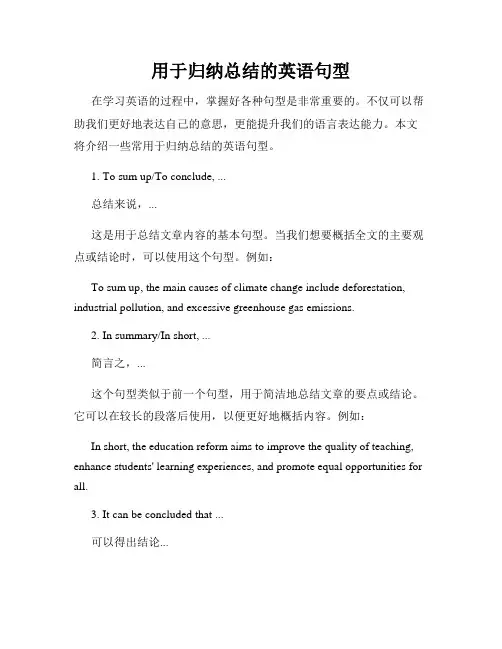
用于归纳总结的英语句型在学习英语的过程中,掌握好各种句型是非常重要的。
不仅可以帮助我们更好地表达自己的意思,更能提升我们的语言表达能力。
本文将介绍一些常用于归纳总结的英语句型。
1. To sum up/To conclude, ...总结来说,...这是用于总结文章内容的基本句型。
当我们想要概括全文的主要观点或结论时,可以使用这个句型。
例如:To sum up, the main causes of climate change include deforestation, industrial pollution, and excessive greenhouse gas emissions.2. In summary/In short, ...简言之,...这个句型类似于前一个句型,用于简洁地总结文章的要点或结论。
它可以在较长的段落后使用,以便更好地概括内容。
例如:In short, the education reform aims to improve the quality of teaching, enhance students' learning experiences, and promote equal opportunities for all.3. It can be concluded that ...可以得出结论...这个句型用于强调某个结论或推论是正确的或明显的。
它通常用于较为正式的写作中,能使文章显得更有权威性。
例如:Based on the research findings, it can be concluded that regular exercise has numerous health benefits, including weight management, reduced risk of chronic diseases, and improved mental well-being.4. From the above analysis, it can be seen/observed that ...通过以上分析,可以看出...当我们需要通过论证或分析来得出一个观点时,可以使用这个句型。
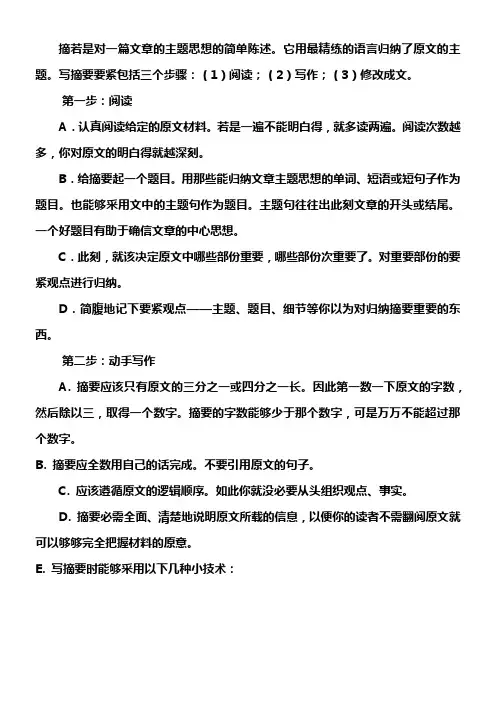
摘若是对一篇文章的主题思想的简单陈述。
它用最精练的语言归纳了原文的主题。
写摘要要紧包括三个步骤:(1)阅读;(2)写作;(3)修改成文。
第一步:阅读A.认真阅读给定的原文材料。
若是一遍不能明白得,就多读两遍。
阅读次数越多,你对原文的明白得就越深刻。
B.给摘要起一个题目。
用那些能归纳文章主题思想的单词、短语或短句子作为题目。
也能够采用文中的主题句作为题目。
主题句往往出此刻文章的开头或结尾。
一个好题目有助于确信文章的中心思想。
C.此刻,就该决定原文中哪些部份重要,哪些部份次重要了。
对重要部份的要紧观点进行归纳。
D.简腹地记下要紧观点——主题、题目、细节等你以为对归纳摘要重要的东西。
第二步:动手写作A. 摘要应该只有原文的三分之一或四分之一长。
因此第一数一下原文的字数,然后除以三,取得一个数字。
摘要的字数能够少于那个数字,可是万万不能超过那个数字。
B. 摘要应全数用自己的话完成。
不要引用原文的句子。
C. 应该遵循原文的逻辑顺序。
如此你就没必要从头组织观点、事实。
D. 摘要必需全面、清楚地说明原文所载的信息,以便你的读者不需翻阅原文就可以够够完全把握材料的原意。
E. 写摘要时能够采用以下几种小技术:1) 删除细节。
只保留要紧观点。
2) 选择一至两个例子。
原文中可能包括5个或更多的例子,你只需从中挑选一至二个例子。
3) 把长段的描述变成短小、简单的句子。
若是材料中描述某人或某事用了十个句子,那么你只要把它们变成一两句即可。
4) 幸免重复。
在原文中,为了强调某个主题,可能会重复论证说明。
可是这在摘要中是不能利用的。
应该删除那些突出强调的重述句。
5) 紧缩长的句子。
如以下两例:“His courage in battle might without exaggeration be called lion-like.”能够归纳为:”He was very brave in battle.”“He was hard up for money and was being pressed by his creditor.”能够归纳为:“He was in financial difficulties.”6) 你还能够利用词组代替整句或从句。
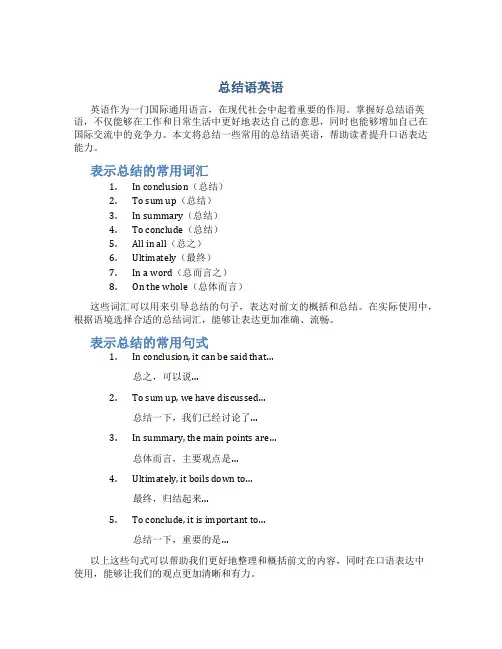
总结语英语英语作为一门国际通用语言,在现代社会中起着重要的作用。
掌握好总结语英语,不仅能够在工作和日常生活中更好地表达自己的意思,同时也能够增加自己在国际交流中的竞争力。
本文将总结一些常用的总结语英语,帮助读者提升口语表达能力。
表示总结的常用词汇1.In conclusion(总结)2.To sum up(总结)3.In summary(总结)4.To conclude(总结)5.All in all(总之)6.Ultimately(最终)7.In a word(总而言之)8.On the whole(总体而言)这些词汇可以用来引导总结的句子,表达对前文的概括和总结。
在实际使用中,根据语境选择合适的总结词汇,能够让表达更加准确、流畅。
表示总结的常用句式1.In conclusion, it can be said that…总之,可以说…2.To sum up, we have discussed…总结一下,我们已经讨论了…3.In summary, the main points are…总体而言,主要观点是…4.Ultimately, it boils down to…最终,归结起来…5.To conclude, it is important to…总结一下,重要的是…以上这些句式可以帮助我们更好地整理和概括前文的内容,同时在口语表达中使用,能够让我们的观点更加清晰和有力。
提供建议和建议总结的表达方式除了总结之外,有时候我们还需要给出建议和建议总结。
以下是一些常用的表达方式:1.I would suggest that…我建议…2.It would be better to…最好…3.It is important to take into consideration…要考虑到…4.Based on the above analysis, I would recommend…根据以上分析,我建议…以上这些表达方式能够帮助我们在总结的基础上给出合理的建议,并且使得建议更加明确和具体。
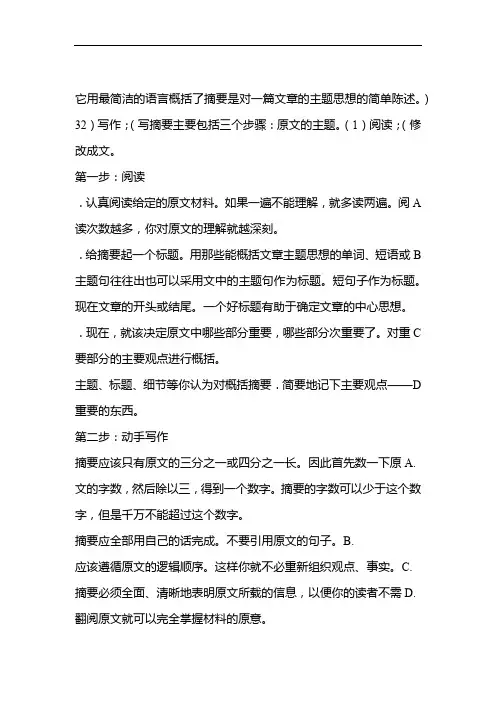
它用最简洁的语言概括了摘要是对一篇文章的主题思想的简单陈述。
)32)写作;(写摘要主要包括三个步骤:原文的主题。
(1)阅读;(修改成文。
第一步:阅读.认真阅读给定的原文材料。
如果一遍不能理解,就多读两遍。
阅A 读次数越多,你对原文的理解就越深刻。
.给摘要起一个标题。
用那些能概括文章主题思想的单词、短语或B 主题句往往出也可以采用文中的主题句作为标题。
短句子作为标题。
现在文章的开头或结尾。
一个好标题有助于确定文章的中心思想。
.现在,就该决定原文中哪些部分重要,哪些部分次重要了。
对重C 要部分的主要观点进行概括。
主题、标题、细节等你认为对概括摘要.简要地记下主要观点——D 重要的东西。
第二步:动手写作摘要应该只有原文的三分之一或四分之一长。
因此首先数一下原A. 文的字数,然后除以三,得到一个数字。
摘要的字数可以少于这个数字,但是千万不能超过这个数字。
摘要应全部用自己的话完成。
不要引用原文的句子。
B.应该遵循原文的逻辑顺序。
这样你就不必重新组织观点、事实。
C.摘要必须全面、清晰地表明原文所载的信息,以便你的读者不需D. 翻阅原文就可以完全掌握材料的原意。
/ 119写摘要时可以采用下列几种小技巧:E.删除细节。
只保留主要观点。
1)个或更多的例子,你只需52) 选择一至两个例子。
原文中可能包括从中筛选一至二个例子。
把长段的描述变成短小、简单的句子。
如果材料中描述某人或某3) 事用了十个句子,那么你只要把它们变成一两句即可。
可能会重复论证说明。
为了强调某个主题,避免重复。
在原文中,4) 但是这在摘要中是不能使用的。
应该删除那些突出强调的重述句。
压缩长的句子。
如下列两例:5)like.”“His courage in battle might without exaggeration be called lion-”He was very brave in battle.”可以概括为:“He was hard up for money and was being pressed by his creditor.”“He was in financial difficulties.”可以概括为:你还可以使用词组代替整句或者从句。
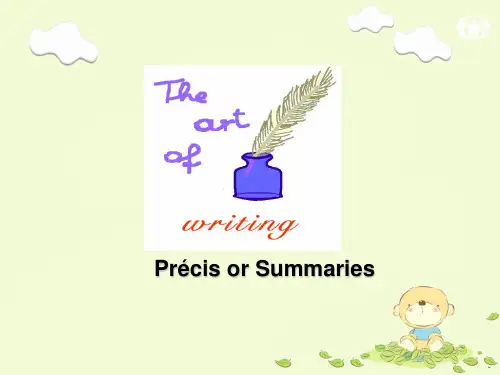
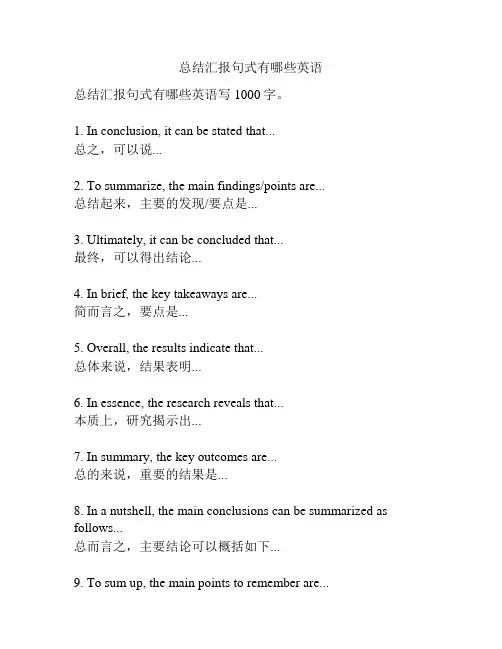
总结汇报句式有哪些英语总结汇报句式有哪些英语写1000字。
1. In conclusion, it can be stated that...总之,可以说...2. To summarize, the main findings/points are...总结起来,主要的发现/要点是...3. Ultimately, it can be concluded that...最终,可以得出结论...4. In brief, the key takeaways are...简而言之,要点是...5. Overall, the results indicate that...总体来说,结果表明...6. In essence, the research reveals that...本质上,研究揭示出...7. In summary, the key outcomes are...总的来说,重要的结果是...8. In a nutshell, the main conclusions can be summarized as follows...总而言之,主要结论可以概括如下...9. To sum up, the main points to remember are...总结一下,需要记住的主要要点是...10. In conclusion, it is evident that...总的来说,显而易见的是...11. To conclude, it is clear that...总而言之,很明显...12. In retrospect, the findings suggest that...回顾过去,研究结果表明...13. To put it concisely, the main findings indicate that... 简言之,主要发现表明...14. All in all, the study highlights...总之,这项研究强调...15. To summarize the main points, it can be stated that... 总结主要要点,可以说...16. To sum it up, the key conclusions are...总的来说,重要的结论是...17. In final analysis, it can be affirmed that...最后的分析中,可以肯定的是...18. In a word, the research demonstrates that...总之,研究表明...19. To wrap up, the main findings suggest that...总结一下,主要发现提示...20. In short, the main implications are...简而言之,主要的影响是...21. In essence, the major takeaways are...本质上,主要的收获是...22. In conclusion, it can be deduced that...总之,可以推断出...23. To sum things up, the key observations are...总而言之,主要的观察结果是...24. Ultimately, it can be inferred that...最终,可以推断出...25. In a nutshell, the main findings suggest...简而言之,主要发现表明...这些句式可以用来进行总结汇报,帮助整理和概括论文、实验结果、研究发现等内容。
高中英语读写任务专题突破---概括S ummary读写任务的写作内容一般分为两个部分, 即写作内容1为概括短文要点, 还有写作内容2 则是就某个主题发表看法。
然而, 绝大部分的考生会忽略了写作内容2对写作内容1的导航作用, 而一头扎进了阅读材料直接去阅读文章得出要点。
事实上, 所谓“读写任务”其实是“读”和“写”的有机结合, “读”的材料是为了后面的“写”提供情景, 同样, “写”也是对“读”的材料的思考和延伸。
因此在概括文章时, 可考虑命题人提供的写作内容2的导航作用, 因为它能够帮助大家更快地提高捕捉文章要点的速度与准确性。
一、概括的标准: 抛弃次要, 瞄准写作目的。
标准的概括一般第一句话是主题句, 清楚明白地告诉了读者文章的写作目的, 这句话的质量决定了概括的成败。
后面的句子对主题句进行解释和支撑, 凡是意义在主题之外的要毫不吝啬地予以删除。
二、概括的写作步骤:1.确定主题句。
确定阅读文章的主题句, 一般在段首。
没有主题句的需要自己组合。
2.寻找关键词。
分析主题句意义, 确定关键词, 关键词一般体现为名词、形容词, 关键词的数目决定了概括的信息浓度。
3.重构主题句。
概括的主题句逻辑上要统摄后面所有的支撑句。
可以从作者的写作目的逆推,反映写作目的主题句是高度抽象的,它基本决定了概括的质量。
4.重组支撑句。
支撑句的意义在逻辑上受制于主题句,可以是补充过程或者提供证据。
口诀:缩长见短, 省却细腻。
四、写概括的具体方法1.写概括的步骤A.定时态:如果阅读材料是过去时, 那么基本时态用过去时;如果是现在的, 那么基本时态用现在时;不过, 模板的开头语一般为现在时如The passagetells us that----- - --.B.定人称: 一般情况下采用第三人称来写作。
(特殊如书信的, 可能会使用第一、二人称;)C.定技巧:结合相关技巧, 重新组句。
1)Use words of similar meanings同义替换法I didn’t catch any fish owing to the fact that I was not patient.I didn’t catch any fish_________ I was not patient.2)Adopt the opposite way when saying a sentence正话反说法Yo.wil.fail..Yo.wil.____________.3)Change the part of speech词性转换法Patienc.i.ver.important.Patienc.i.o. ____________________..4)Change the structure of a sentence句式变化法语态变换: Parents should give children more praise.→Children should ________ more praise.简单句变复合句:Childre.shoul.b.encourage.more.Thi.wil.hel.the.lear.faster.Children should be encouraged more, _______ will help them learn faster..5)Use the shortest possible transitions连词衔接法注意使用一些短而精的连词, 如but, and, so, while, however, then, yet, for, therefore, thus, including, instead of 等。
Summary 常用句式 1. This article/ passage mainly tells (a story) about…… 2. This passage mainly deals with/discusses/explores/…… 3. In this passage (about ……), the author …… 4. In this passage about …… , the author …… 5. The author began the essay/ passage by telling/ presenting…… 6. First/Firstly/ In the beginning/In the first part, the author argues/ explains/ mentions/ states/ points out (that)…… 7. Secondly/ Next/ Further on/ Then/ In the next part/ In the main part, the author goes on with…… 8. Finally/ As a conclusion/, the author concludes/ adds/ stresses that…… 9. Finally, the author summarizes that ……
二、常见句型 1)This paper deals with.. 2)This article focuses on the topics of (that,having,etc). 3)This essay presents knowledge that... 4)This thesis discusses... 5)This thesis analyzes... 6)This paper provides an overview of... 7)This paper elaborates on .. 8)This article gives an overview of... 9)This article compares...and summarizes key findings. 10)This paper includes discussions concerning... 11)This paper presents up 12)This article covers the role of chemicals in... 13)This paper addresses important topics including... 14)This paper touches upon... 15)This paper strongly emphasizes.. 17)This article not only describes...but also suggests... 18)This paper considers... 19)This paper provides a method of ... 20)This paper introduces an applicable procedure to analyze... 21)This paper offers the latest information regarding... 22)This paper is devoted to examining the role of... 23)This article explores... 24)This paper expresses views on... 25)This paper reflects the state of the art in... 26)This paper explains the procedures for...¬ 27)This paper develops the theory of .. 28)This article reviews the techniques used in... 29)This paper investigates the techniques and procedures to... 30)This article is about... 31)This essay is related to ... 32)This paper concerns... 33)This paper gives an account of ... 34)This article tells of... 35)This paper tries to describe... 36)This paper provides an analysis of ... 37)This paper reports the latest information on .. 38)The author of this article reviews.. 39)The writer of this paper discusses... 40)The writer of this essay tries to explore... 41)The aim of this paper is to determine.. 42)The purpose of this article is to review... 43)The objective of this paper is to explore... 破题用语,一般有: ① The author of this article reviews (or: discusses, describes, summarizes, examines) something…… ② This article reviews (or:reports,tells of,is about,concerns)something……. ③ This article has been prepared (or:designed,written)……. ④ The purpose of this article is to determine something……. ⑤ The problem of something is discussed ……. 结论和建议,一般有以下几种写法: ① The author suggests (recommends,concludes)that……. ②This article shows that……. ③ It is suggested that……. ④The author's suggestion (or:conclusion )is that …… ⑤The author finds it necessary to ……. Useful Transitions and Transitional Phrases Introduction to a Topic as for, concerning, with regard to, with respect to, in terms of
To Summarize in all, in a word, in brief, briefly, in other words, in short, in summary, that is, finally, generally, in conclusion, on the whole, therefore, to sum up, to conclude, and so, this shows, thus we see
To Compare by comparison, here again, in the same way, in a similar manner, likewise, similarly, so too, as, also, equally, accordingly, moreover, as well, and
To Contrast conversely, however, instead (of), in spite of that, anyhow, on the contrary, on the other hand, otherwise, rather than, still, yet, nevertheless, in contrast, notwithstanding, in spite of this, although, but, despite, even though To Show Cause and Effect accordingly, as a consequence, as a result, consequently, for this reason, hence, it follows that, so/so that, then, therefore, thus, thereupon
To Explain actually, admittedly, because, certainly, for example, in fact, indeed, really of course, since, that is, for instance, namely, specifically, such as, to illustrate, in particular, in this manner, thus
To Show Conviction
after all, at least, at the same time, apparently, even so, evidently, certainly, conceivably, conclusively, doubtless, no doubt, perhaps, possibly, presumably, probably, surely, undoubtedly
To Show Various Conditions in this event, in these circumstances, this (that) being so, provided that, in spite of, none/nevertheless, at the same time, even if, if, unless, otherwise, although, even though, though, despite